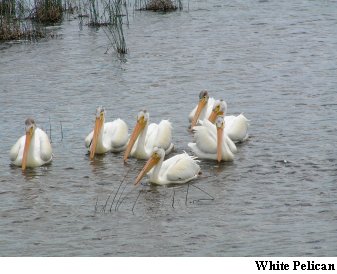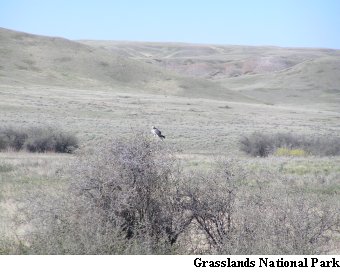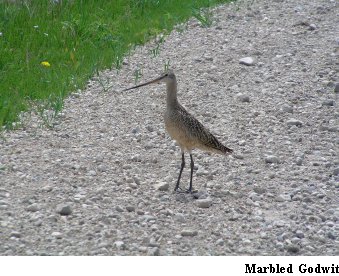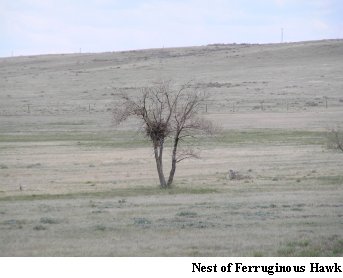Your front row seat awaits for the Dancing Lek of the Sharp-tailed Grouse and Greater Prairie Chicken in Bird Songs of the N.A. Prairie 2CD . The sounds of 168 bird species and 6 mammals are beautifully recorded on this production which features the Grasslands of North America in great detail. Birds from potholes, marshes, lakes, and forested prairie hills sing into the microphone of John Neville, renowned nature recordist. Listen to the descending whistle of Sprague's Pipit displaying 100 meters above their nest site. Listen to the beautiful songs of the rare McGown's Longspur, Baird's Sparrow and Prairie Warbler. Three examples are given of the Great Horned Owl and Marbled Godwit. Experience the diversity of the North american Prairie with Nature Recordist John Neville. See Below. A NATURE RECORDIST ON THE PRAIRIES Copyright 2006: by John Neville Does the open grassland stretch from horizon to horizon on the prairies and is it really flat? We set out from Police Outpost Provincial Park, Alberta to find out. My wife and I travel in a motorhome we call the Bird Mobile. The primary goal was to record birdsongs and enjoy the birds and their vocalizations not just on the grasslands but also in the many wetlands. Police Outpost is right on the Montana--Alberta border. When we arrived on the evening of April 25th there were four pairs of Red-necked Grebe right along the shoreline of a mid-sized lake. In addition to calling they were performing their courtship ritual: scooting across the water to touch breasts, then swimming parallel with necks out-stretched. It's always a relief to get the first good recording and their constant displaying made it very easy. There were strong gusts of wind overnight but it was fairly calm at 6 am when I walked quietly along a trail to listen to Sandhill Cranes feeding in Outpost Lake. There were also three kinds of gull, Canada Geese, Robins, Wilsonís Snipe displaying overhead and a Common Loon far out on the water. Travelling east three days later we got our first general look at the landscape. Yes, much of it was flat or more accurately gently rolling. Cattle grazed in fenced fields and in one enclosure buffalo roamed. Potholes provided water at regular intervals. Where we stopped for lunch Chorus frogs and the wind accompanied our bowl of soup. We passed a small ghost town called Whisky Gap. In the mid 19th century whisky traders came north from Fort Benton on the Missouri to exchange their rotgut whisky for Buffalo robes and pelts with the Indians. Fort Whoop Up in Lethbridge, where much debauchery took place has been restored. During prohibition, liquor found its way south along the same routes. In one field a large erratic signposted an old glacial deposit. On a farm fencepost a Red-tailed Hawk watched our passing. The fields were still coated in gold and brown shaded crop stubble. More posts had Bluebird boxes and some were occupied. Mallard and Northern Shoveller were the most common occupants of the potholes. More and more regularly an abridged burst of Western Meadowlark song would enter the open windows. A Savannah Sparrow with a pleasing arpeggio sang from a fencepost. A Sandhill Crane was busy probing a muddy ditch and didn't trouble to lift his head as we passed.  Just as the flat land was starting to become monotonous we dropped down into the Milk River valley. Lewis and Clarke named it, as it reminded them of the colour of tea, with a dash of milk added. The music of Meadowlarks increased along the valley and ten Antelope bounded away from the roadside. The Writing-on-Stone Provincial Park is a weird place! You can't miss the spiritual atmosphere, with hoodoos, pictographs and stone carving of First Nations People, going back eons in time. The backdrop to this park is the Sweetgrass Hills in Montana. At dusk we listened to the unearthly calls of Coyote, like tortured souls searching for a resting place. Our route took us across rural southern Alberta. The largest vehicle we encountered was a school bus. Northern Harriers and Swainson's Hawk became more familiar sites, taking off from fields or watching us pass from fence posts. Pakowki Lake was a delight. It had the most Yellow-headed Blackbirds, jostling for territory, we had encountered since Creston, BC. Their raucous sounds were a pleasure to record, and so close! We counted over 40 species in the area including American Bittern, Sora, Ruddy Duck, Willet, American Coot, and Marbled Godwit. Our next stop was at Red Rock Coulee, where I recorded my first Vesper's Sparrow of this trip. After creeping towards a Gray Partridge for several minutes, he suddenly exploded into flight--all I managed to record was a flurry of feathers! We next chose a gravel road to Elkwater Lake and the Cyprus Hills. It was very quiet, only two vehicles passed us on the 50 kilometer route. We stopped and enjoyed the birds and our first glimpse of prairie Lodgepole Pine and Spruce trees. Meadowlark, Vesper's sparrow, Horned Lark and Redwings became so common that we almost overlooked them. The waddling form of a Porcupine moved away from us on one ranch. At Michel Lake I recorded Ring-billed Gull, Killdeer and the harsh flight sound of American Widgeon. Before reaching Elkwater a huge flock of Redwings flew over us heading north.  The Cyprus Hills are interesting for a number of reasons: for example, they reach an elevation of 5,000 feet, or about the same height as Banff. The highest 100 meters were not covered during the Last Ice Age, so a number of plants remain special to the area The last rainstorm on the prairie had turned to snow on the hills. The dark green spruce and pine have a similar appearance to the montane zone of the Rockies. At lower levels poplar groves create parkland with the open grassland. These features provide most of the bird species you would find in the mountains: Northern Flicker, Red-naped Sapsucker, Ruby-crowned Kinglet, Roughed Grouse and many more. The Pink-sided race of Junco was a local phenomenon, but I only managed to record the contact notes. There were 26 White Pelican on Reesor Lake and Osprey catching trout. A pair of Coyote and a Red Squirrel were also good subjects to record. Our next stop was a large ranch on the Alberta-Saskatchewan border. The Hargreaves not only manage a successful ranching operation but they are very serious stewards of the land. On the reservoir 28 White Pelican were fishing in a tight circle. The abundance of Sprague's Pipit indicated the health of the grassland. After waiting through two days of prairie storms I was able to record the pipit, Chestnut-collared Longspur, Swainson's Hawk, Marbled Godwit, and Savannah Sparrow. I missed just as many more for various reasons. Heading down the east side of the Cyprus Hills I heard three different Song sparrows. At Cyprus Lake I walked too close to a large nest only ten feet off the ground. The female Ferruginous Hawk suddenly emerged from the eerie and flew over my head. I stood quite still, just long enough to record 5 of her calls. As we drove away a Jackrabbit popped up from the grass ahead of us. He would probably be dinner for the young hawks in a few weeks time? Our route across Saskatchewan led to the Frenchman River. The road descended steeply for about one kilometer. The valley has coulees and cliffs. The town of Eastend has preserved a locally excavated Tyrannosaurus Rex. These large animals roamed this region between 65 and 85 million years ago. At the museum you can see the fossilized skeleton is almost complete! Later, I walked the road recording and just enjoying a sunny morning by the river. Mating Mourning Doves, Black-billed Magpies, Brown-headed Cowbirds, Clay-coloured Sparrow, Willet, Northern Flickers, Swainson's Hawk, Wild Turkey, Mallard and others entertained me. There were also Yellow Warbler, Yellow-rumped Warbler and Chipping Sparrow for the first time on the trip. The date of these newly arrived migrants was May 14th. Later at the village of Frontier we stopped at a shallow slough. A flock of tiny Wilson's Phalarope would swarm, like insects, above the water then settle down again in pairs of nodding heads.  The visit to Grasslands National Park had been anticipated for months. It is a remarkable piece of minimally spoiled prairie and is now protecting habitat for many prairie species. It was in this area in 1876 that Sitting Bull and Red Cloud, crossed the border just ahead of the Seventh Cavalry. One of the parks specialties is the Prairie Dog town along the Eco Tour Road. It was delightful just to walk along the road at dusk with dogs calling on either side. The foIlowing morning I thought Heather was walking along the road behind me but found a Coyote curiously loping along about 100 meters back. Clay-coloured sparrow and Lark bunting were two of the birds I recorded. The later arrived on May 16th and were flying on territory by May 18th. We missed a very special event by only 6 days. After an absence of 125 years, 50 Buffalo were to be released into the park! Grasslands National Park is truly an oasis for many species. Just one-month earlier Bird Studies Canada reported that 34 out of 39 grassland species were in serious decline. Less than 1 per cent of the Canadian Prairie grasslands now exist in their natural state. Since 1966 most prairie species have been declining at an average rate of 2% per annum. The day we left, heading east, the temperature reached + 30íC, causing thermals and strong winds. One swirling twister was carrying topsoil 60 to 90 meters into the air. After a quick stop on the Souris River we headed to Moose Mountain. A logging road leading to Stevenson Lake proved ideal for us. Tennessee, Yellow and Mourning Warblers had just arrived. The next day they were joined by more Boreal Forest critters including: Ovenbird, Chestnut-sided, Black and White, Bay-breasted and Wilson's warblers. The biggest thrill came on a calm clear evening when the local Common loon sang, intermittently, for an hour and a half! Naturally, I enjoyed making several good recordings. Oak-Plum Marsh was our first stop in Manitoba. There were so many birds along the gravel dyke that it was very difficult to separate individuals to record. Where Oak Lake was flooding over a dam into Plum Lake, several fishermen were enjoying a bumper harvest of large pike! The oaks were great habitat for Baltimore oriole, Mourning dove, Catbird and Yellow warbler. The latter were difficult to record because of the high frequency of their songs. Finally I stood under an oak, and focused straight upwards, using the silent sky as a backdrop. Later Eared grebe and Black terns came close enough to record. Next we took a long drive of 300 kilometers to the Tall Grass Prairie Preserve. Road-killed skunk, Garter snake and Red fox were seen along that part of the trip. The Tall Grass had recently been burned to simulate natural prairie conditions. Le Conte's joined Vesper's, Savannah and Clay-coloured sparrows on the growing list of recordings. For the first time Blue jay joined orioles and robins among the birch and aspens. Perhaps, the most numerous critters were the tics that needed constant removal from clothing and skin! The next morning I stood on the edge of a shallow wetland trying to record a small bird with three single notes followed by a trill? The little brown bird had a white throat and some white striping on his shoulders and head. Yes, it was my first Sedge wren. Windy weather delayed further recording for 4 hours, but Swamp sparrows, House wren, Catbird, Yellow-throated vireo, were soon added to the growing number of species. Less adequate recordings were also made of Sandhill crane, Red-tailed hawk, Warbling vireo and Upland sandpiper. You canít win them all! Anyone wishing to visit the Tallgrass Prairie Preserve will have a wonderful experience if they are interested in plants, or birds. The Big Bluestem grass really grows as high as an elephantís eye. Check with the field office for directions to pursue your particular interest. Saturday morning 27th of May found us parked in the Souris River Valley. The bright yellows of American goldfinch were flitting amongst the Aspen. Barn swallows were examining the overhang at the front of the vehicle. Twice swallows had flown into the Bird mobile to see if the accommodation was suitable for their use? The mixed grassland and deciduous forest overlooked the meandering Souris interlaced with sandbars. Sadly, a rainstorm caused us to leave the Souris Valley before the dirt roads became impassable.  Turtle Mountain rises about 250 meters above the plain and includes more than 200 lakes. It is well forested with deciduous and evergreens and some grasslands. The Loons were, as always, a delight to hear. A Common yellowthroat, with an a-typical song attracted my microphone first. More wet, windy weather decided us to move on.
Turtle Mountain rises about 250 meters above the plain and includes more than 200 lakes. It is well forested with deciduous and evergreens and some grasslands. The Loons were, as always, a delight to hear. A Common yellowthroat, with an a-typical song attracted my microphone first. More wet, windy weather decided us to move on. The nickname Poverty Plains was given to the southwest corner of Manitoba during the dirty thirties when many people were left poverty stricken. Now several blocks of land are preserved for wildlife management although oilrigs have sprouted in some places. It was in the Frank Boyd section right next to a disused rig that Heather heard Bobolink during an evening stroll. The following morning I set out across the grassland towards the rig. The wind was moderate but two hands were still needed to steady the microphone! Suddenly a Bobolink launched himself into the air and began to sing. The prolonged musical chatter is sweet but a melody is somewhat illusive. However, the song, like the meadowlarkís, enriches the prairie. I spent two hours maneuvering myself between the birds so that my back was towards the wind. Gradually I became accepted and moved within a few meters to record, these black birds with white naps and rumps. One Bobolink accompanied me, flying small arcs, still singing, as I slowly moved away. It was so good to briefly be part of their world. The third block of Poverty Plains we visited still had old Buffalo wallows! The mixed Grassland also had a small colony of Upland sandpipers, which proved illusive but not impossible to record. When the wind dropped the simple song of an Indigo bunting was also captured. Back in Saskatchewan we visited the Quill Lakes International Birding Area, North America's largest saltwater marsh. Lots of the birds we saw and heard were familiar from other areas. The most noticeable difference was the shear numbers of each species. I got my best recordings so far of Common terns, Le Conte's sparrow, Coyote and Marsh wrens. It was only the second place we heard Bobolink on the Wildflower Trail. At the north end of Last Mountain Lake is North Americaís oldest bird reserve, established in 1887. There are extensive grasslands and marshes. Encountering Short-eared owls at dawn was one of our greatest thrills! The birds were hunting near the road and several times came very close. Brewer's and Rusty blackbirds, Western kingbirds and good recordings of Sora were made. A nice surprise was a Red-tailed hawk, which called from a grove of Box Alder at my approach. The visitorís kiosk informed us that the three Prairie Provinces produce 70 % of North America's duck population. Certainly, in the marshes and sloughs we have noticed an abundance of coot, Blue-winged teal, Mallard, Redhead and shovellers. Last Mountain is a large lake with a variety of habitats for all 6 members of the grebe family, 3 scoter species, golden-eye, Greater scaup, loons, gulls, cormorants and the bird that casts the greatest shadow, the White pelican. At Douglas Provincial Park, on Lake Diefenbaker we had hoped to see or hear the endangered Piping plover but rain and wind kept us confined largely to the Bird Mobile. On the third morning I emerged briefly to record a Veery and a Red-eyed vireo. There was a little too much wind in the recordings but it was still the highlight of that stop. We drove over the Gardner Dam 200 kilometers along Diefenbaker Lake to the Saskatchewan Landing Provincial Park. We continued to luck out on Piping plovers but there were a few treats. First, we resolved two question marks: the dark-headed Cassin's vireos were Blue-headed vireos, and the towhees that sounded like Eastern Towhees were actually Spotted towhees. I was able to record both of these species, plus Cooper's hawk hidden in the Alder of a coulee, and my first Lark sparrows. For all of those reasons we will remember Saskatchewan Landing. The friendly staff at the Chaplin Nature Center, on the Trans Canada Highway, directed us to Chaplin Lake and Marsh. We traveled a very attractive dyke for birding and eventually enjoyed it. I say eventually because the first evening and night we were subject to a deafening thunderstorm. It shuck the air, ground, and us. Hail pounded the Bird mobile and winds very nearly blew the vehicle over. A mature tree in Chaplin was completely ripped out of the ground by its roots! It was quite scary at the time! 24 hours later, before dawn, I was able to successfully record Virginia rail, Yellow rail, (a first for me) Western grebe, Marsh wren, Black-crowned Night heron and an Avocet. Returning to the Cyprus Hills was the last birding location on the trip. Approaching from the west this time we ascended a dramatic zigzag road through forests and a grassland plateau. The next morning I set out at 4 am to walk the road between the Saskatchewan and Alberta sides of the hills. It consisted of mixed woodland, open grassland and several small marshes and creeks. It was a fitting climax to our prairie adventure, allowing me to drink in the varied habitats, and add American Redstarts, Swainson's Thrush, White-crowned Sparrow and Orange-crowned Warbler to the more than 80 species recorded. Enjoying the landscape and the wonderful variety of birds makes us look forward to next yearís trip. We plan to visit the Great Plains, in a number of states, just to the south of us. John Neville is an Author and nature recordist. |